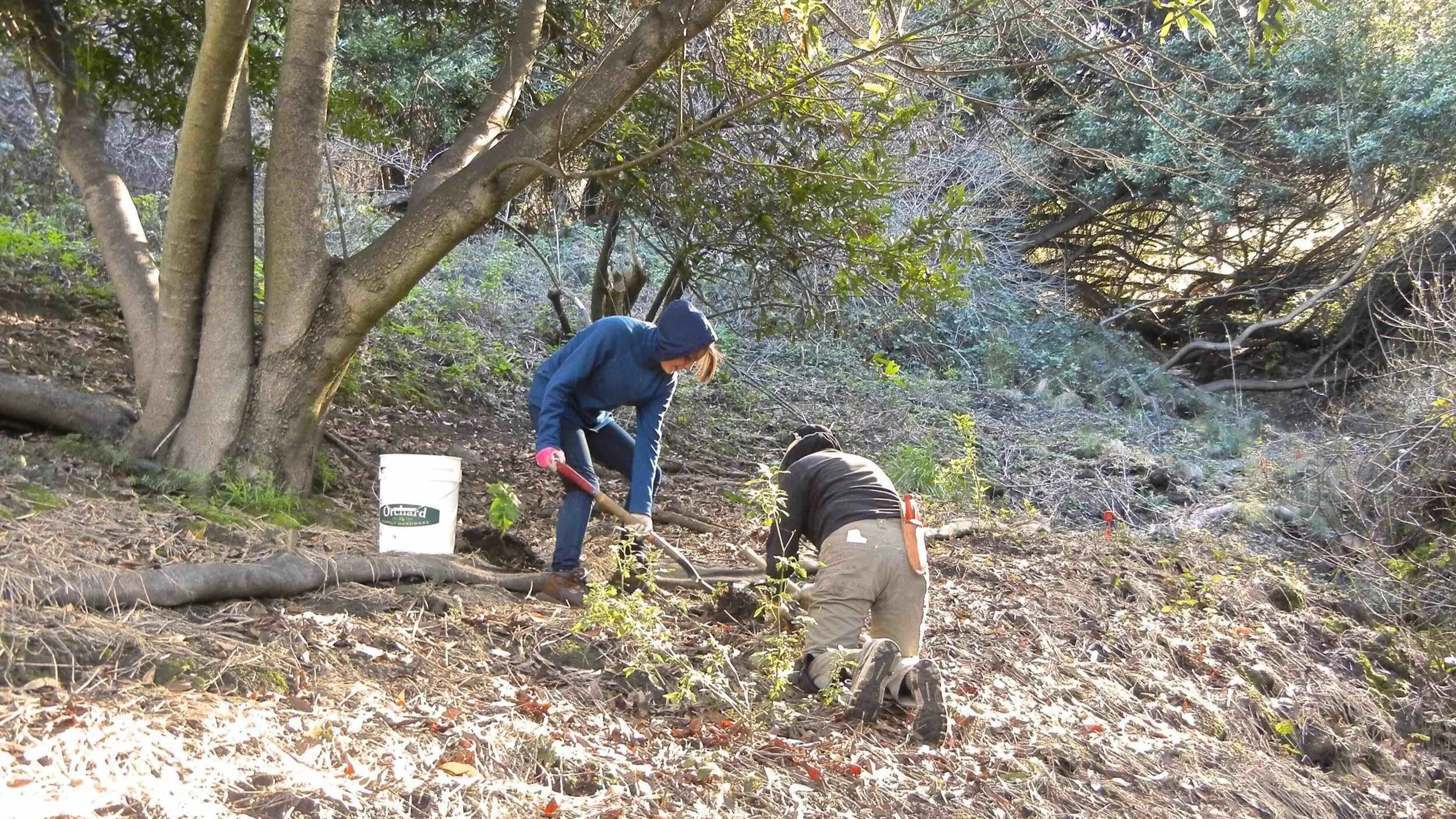Drive up Claremont Avenue east the rock chert on your left and pause at the gate at Sign Post 29 on your right. The vista from this point gives you a chance to see what the Conservancy has been doing to restore our canyon and make it accessible to stewardship volunteers and hikers alike.
Winter bird walk with Dave Quady, by Kay Loughman
Restoring a north coastal grassland, by Marilyn Goldhaber
A tenth anniversary, by L. Tim Wallace
Spring Bird Walk: this morning in Claremont Canyon, by Dave Quady
Birds and birding in Claremont Canyon, by Kay Loughman
From the president's desk, by L. Tim Wallace
THIS WILL BE THE CONSERVANCY’S TENTH YEAR anniversary, and we want to celebrate it with you—not only on November 6th at our Annual Meeting (mark your calendars), but throughout the year. At each of our nature walks, at each of our stewardship days where ever they may be in Claremont Canyon, at each of our special events, we all hope you join us and become part of the discussion about the local treasure that is Claremont Canyon.
Honoring our members, by Marilyn Goldhaber
HONORING OUR MEMBERS: From our founding in 2001, we have encouraged nearby residents and community organizations to support the Conservancy by becoming Founding Sponsors with a commitment to contribute $1,000, either all at once or over ten years. We are pleased to list in our Spring 2011 newsletter, in approximately the order the commitments were made, our first 209 Founding Sponsors.
Winter birding field trip, by Kay Loughman
A botanical exploration with Lech Naumovich, by Marilyn Goldhaber
Native plants at the Pacifica site with Jake Sigg, by Marilyn Goldhaber
A DOZEN CONSERVANCY MEMBERS AND FRIENDS visited the Pacifica Foundation site of the KPFA Radio Towers overlooking Gwin and Claremont Canyons, with Jake Sigg, long-time advocate of native plant restoration in the Bay Area and author of the widely read “Nature News from Jake Sigg.” Jake helped us identify native plants and provided insights on the landscape, a naturally rough and exposed knoll overlooking much of the bay area to the west and Mount Diablo and the inner valley to the east.
President's message, by Barry Pilger
AS SUMMER TURNS TO FALL Claremont Canyon can take on a special beauty after our recent relatively wet spring and mild summer. A drive up Claremont Avenue, or better yet a walk onto a canyon trail, whether through Garber Park, from Four Corners to the chert, or a more ambitious hike from the Stonewall trailhead to Grizzly Peak Boulevard and back, is just what one needs to be reminded of the natural beauty that is right in our backyard.
Wildfire hazard reduction and resource management plan-an update, by Pat O'Brien
ON APRIL 20, 2010 THE PARK DISTRICT Board of Directors unanimously approved the Park District’s Wildfire Hazard Reduction and Resource Management Plan and its accompanying EIR. The approval followed six years of hard work by staff, consultants, natural resource specialists, planners, cooperating agencies, and the public, and will pave the way for important fire hazard reduction work to begin in Claremont Canyon and several other East Bay Hills regional parks.
Making Claremont Canyon fire-safe, working with UC
Over the last nine years, the Conservancy has developed a strong working relationship with the University of California and its restoration and fire safety projects in Claremont Canyon. Much of our shared concern has focused on the dense groves of eucalyptus on U.C. land in the upper portion of the Canyon.
Weedworkers Toolbelt, by Mary Millman
"Over the years I’ve developed a way to incorporate most of the items I need in the field into a light, compact, easily carried system that provides quick access to everything without compromising my mobility, and still leaves both hands free. And, I don’t forget anything—It’s all right there!” Items on Ken’s belt from left to right are: anvil loppers in cordless drill holder, accessory pouch for camera, GPS, first aid, LED flashlight, etc., folding saw, small spray bottle, anvil pruners, and small monocular."
Found: 1895 Alameda-Costra county boundary marker, by Mary Millman
SOMETIMES IMPORTANT THINGS end up in unexpected places. In 1895 several 400-pound cast iron boundary markers were placed along the ridgetop boundary between Alameda County and Contra Costa County. One was positioned right at the top of Claremont Canyon, close to what we know as “Four Corners,” the intersection of Grizzly Peak Boulevard and Claremont Avenue/Fish Ranch Road.
Goat grazing in the East Bay Hills, by Martin Holden
Twentieth century canyon dwellers, by Mary Millman
ALTHOUGH WE ARE NOW IN THE MIDST of a comprehensive project to collect an audio history of Claremont Canyon, the beginnings sprang from a casual curiosity about the early days in the canyon. Our board member, Tamia Marg, who spent her childhood there remembered “Tappy” Marron, whose family built the house that the Park District now occupies at the end of Gelston Road.
French broom-A tenacious invader, by Mary Millman and Tamia Marg
A brief history of wildfire in Claremont Canyon
IN THE BEGINNING: Throughout the latter part of the 1800s, Claremont Canyon, like much of the East Bay Hills, was utilized primarily for cattle grazing and dairy farming. The landscape was mostly grassland, a likely mixture of native bunch grasses and exotic annual grasses with a scattering of native shrubs and trees.


